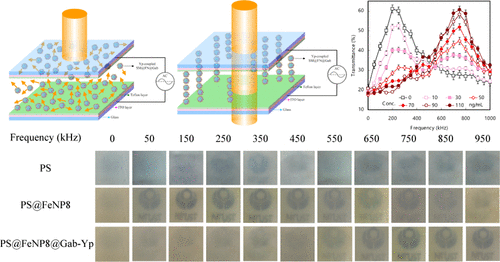Our official English website, www.x-mol.net, welcomes your feedback! (Note: you will need to create a separate account there.)
Electrorheological Sensor Encapsulating Microsphere Media for Plague Diagnosis with Rapid Visualization.
ACS Sensors ( IF 8.9 ) Pub Date : 2019-12-23 , DOI: 10.1021/acssensors.9b01529 Pai-Chien Chou,Feng-Ping Lin,Hui-Ling Hsu,Chi-Jung Chang,Chien-Hsing Lu,Jem-Kun Chen
ACS Sensors ( IF 8.9 ) Pub Date : 2019-12-23 , DOI: 10.1021/acssensors.9b01529 Pai-Chien Chou,Feng-Ping Lin,Hui-Ling Hsu,Chi-Jung Chang,Chien-Hsing Lu,Jem-Kun Chen

|
Plague is a disease infected by an etiological agent, which is transmitted from fleas to a variety of wildlife rodents. Therefore, rapid diagnosis of plague on-site in the field is important. Polystyrene microspheres (SMs) of 2.2 μm diameter were synthesized by emulsion polymerization to adsorb magnetic nanoparticles (FNs), resulting in core-/shell-structured microspheres that generate a significant contrast in relative permittivities between SMs and FNs. Electrorheological displays (EDs) consisting of two indium tin oxide glasses with spacers were constructed to contain core-/shell-structured SM/FN (SM@FN) solutions for observing their transmittance change. The ED encapsulating dispersed SM@FN solution exhibited an opaque state because light was scattered significantly without the application of an alternating electric field (AEF). In the presence of an AEF, the particle chaining behavior results in enhancement of the transmittance of ED. At a specific frequency, the so-called characteristic frequency (Fc), the transmittance reaches a maximum. Fc could be used as an indicator to mark the shell materials. The antibody of Yersinia pestis (ab-Yp) was coated onto the SM@FN as a biosensing medium. The Fc of ab-Yp-modified microspheres shifted from 200 to 750 kHz with antigen coupling of Y. pestis antigen (ag-Yp). In the absence of fluorescence labeling, the large change in ED transmittance could be visualized during the Y. pestis detection. The limit of detection and the limit of quantification were ∼30 and ∼40 ng/μL, respectively, obtained within 30 s according to the highest transmittance of ED under the AEF at 750 kHz. Y. pestis detection was not affected by Escherichia coli and Staphylococcus aureus significantly. Compared with other common immunoassays, including the secondary immunochemical or enzyme-linked steps, this simple electrorheological sensor with high sensitivity and selectivity could be a candidate for on-site plague diagnosis.
中文翻译:

封装微球介质的电流变传感器,用于快速可视化的鼠疫诊断。
鼠疫是一种由病原体感染的疾病,由跳蚤传播给各种野生啮齿动物。因此,现场快速诊断鼠疫非常重要。通过乳液聚合合成直径为 2.2 μm 的聚苯乙烯微球 (SM) 以吸附磁性纳米粒子 (FN),从而产生核/壳结构的微球,其在 SM 和 FN 之间的相对介电常数上产生显着差异。电流变显示器 (ED) 由两个带隔板的氧化铟锡玻璃组成,其中包含核/壳结构的 SM/FN (SM@FN) 溶液,用于观察它们的透射率变化。封装分散的 SM@FN 溶液的 ED 呈现不透明状态,因为在没有施加交变电场 (AEF) 的情况下光被显着散射。在存在 AEF 的情况下,粒子链行为导致 ED 的透射率增强。在特定频率,即所谓的特征频率 (Fc),透射率达到最大值。Fc可以作为标记外壳材料的指标。鼠疫耶尔森氏菌抗体 (ab-Yp) 包被在 SM@FN 上作为生物传感介质。ab-Yp 修饰的微球的 Fc 从 200 到 750 kHz 与鼠疫杆菌抗原 (ag-Yp) 的抗原偶联。在没有荧光标记的情况下,可以在鼠疫耶尔森氏菌检测期间观察到 ED 透射率的巨大变化。根据 ED 在 750 kHz 下 AEF 下的最高透射率,在 30 秒内获得检测限和定量限分别为 ∼30 和 ∼40 ng/μL。Y。鼠疫检测不受大肠杆菌和金黄色葡萄球菌的显着影响。与其他常见的免疫分析方法相比,包括二次免疫化学或酶联步骤,这种简单的电流变传感器具有高灵敏度和选择性,可以成为现场鼠疫诊断的候选者。
更新日期:2019-12-25
中文翻译:

封装微球介质的电流变传感器,用于快速可视化的鼠疫诊断。
鼠疫是一种由病原体感染的疾病,由跳蚤传播给各种野生啮齿动物。因此,现场快速诊断鼠疫非常重要。通过乳液聚合合成直径为 2.2 μm 的聚苯乙烯微球 (SM) 以吸附磁性纳米粒子 (FN),从而产生核/壳结构的微球,其在 SM 和 FN 之间的相对介电常数上产生显着差异。电流变显示器 (ED) 由两个带隔板的氧化铟锡玻璃组成,其中包含核/壳结构的 SM/FN (SM@FN) 溶液,用于观察它们的透射率变化。封装分散的 SM@FN 溶液的 ED 呈现不透明状态,因为在没有施加交变电场 (AEF) 的情况下光被显着散射。在存在 AEF 的情况下,粒子链行为导致 ED 的透射率增强。在特定频率,即所谓的特征频率 (Fc),透射率达到最大值。Fc可以作为标记外壳材料的指标。鼠疫耶尔森氏菌抗体 (ab-Yp) 包被在 SM@FN 上作为生物传感介质。ab-Yp 修饰的微球的 Fc 从 200 到 750 kHz 与鼠疫杆菌抗原 (ag-Yp) 的抗原偶联。在没有荧光标记的情况下,可以在鼠疫耶尔森氏菌检测期间观察到 ED 透射率的巨大变化。根据 ED 在 750 kHz 下 AEF 下的最高透射率,在 30 秒内获得检测限和定量限分别为 ∼30 和 ∼40 ng/μL。Y。鼠疫检测不受大肠杆菌和金黄色葡萄球菌的显着影响。与其他常见的免疫分析方法相比,包括二次免疫化学或酶联步骤,这种简单的电流变传感器具有高灵敏度和选择性,可以成为现场鼠疫诊断的候选者。


























 京公网安备 11010802027423号
京公网安备 11010802027423号